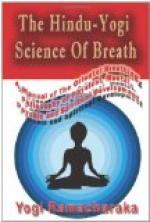(3) Inhibiting pain.
Lying down or sitting erect, breath rhythmically, holding the thought that you are inhaling prana. Then when you exhale, send the prana to the painful part to re-establish the circulation and nerve current. Then inhale more prana for the purpose of driving out the painful condition; then exhale, holding the thought that you are driving out the pain. Alternate the two above mental commands, and with one exhalation stimulate the part and with the next drive out the pain. Keep this up for seven breaths, then practice the Cleansing Breath and rest a while. Then try it again until relief comes, which will be before long. Many pains will be found to be relieved before the seven breaths are finished. If the hand is placed over the painful part, you may get quicker results. Send the current of prana down the arm and into the painful part.
(4) Directing the circulation.
Lying down or sitting erect, breathe rhythmically, and with the exhalations direct the circulation to any part you wish, which may be suffering from imperfect circulation. This is effective in cases of cold feet or in cases of headache, the blood being sent downward in both cases, in the first case warming the feet, and in the latter, relieving the brain from too great pressure. In the case of headache, try the Pain Inhibiting first, then follow with sending the blood downward. You will often feel a warm feeling in the legs as the circulation moves downward. The circulation is largely under the control of the will and rhythmic breathing renders the task easier.
(5) Self-healing.
Lying in a relaxed condition, breathe rhythmically, and command that a good supply of prana be inhaled. With the exhalation, send the prana to the affected part for the purpose of stimulating it. Vary this occasionally by exhaling, with the mental command that the diseased condition be forced out and disappear. Use the hands in this exercise, passing them down the body from the head to the affected part. In using the hands in healing yourself or others always hold the mental image that the prana is flowing down the arm and through the finger tips into the body, thus reaching the affected part and healing it. Of course we can give only general directions in this book without taking up the several forms of disease in detail, but a little practice of the above exercise, varying it slightly to fit the conditions of the case, will produce wonderful results. Some Yogis follow the plan of placing both hands on the affected part, and then breathing rhythmically, holding the mental image that they are fairly pumping prana into the diseased organ and part, stimulating it and driving out diseased conditions, as pumping into a pail of dirty water will drive out the latter and fill the bucket with fresh water. This last plan is very effective if the mental image of the pump is clearly held, the inhalation representing the lifting of the pump handle and the exhalation the actual pumping.




